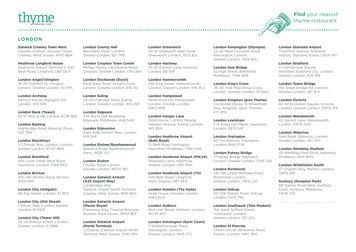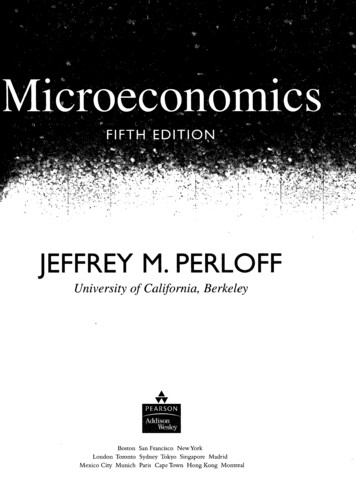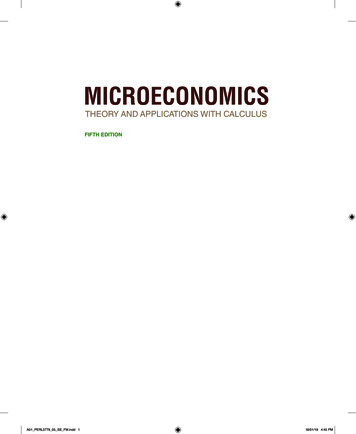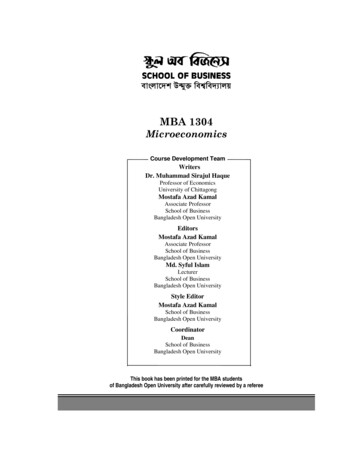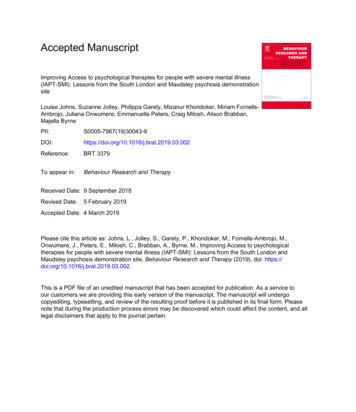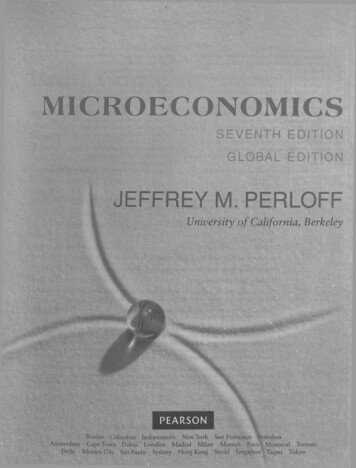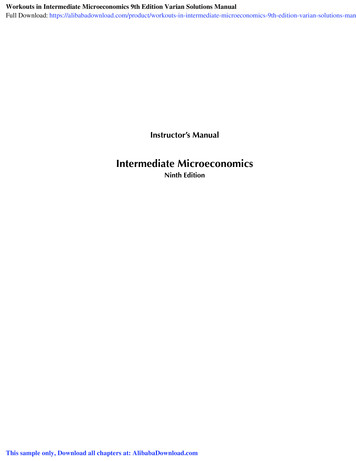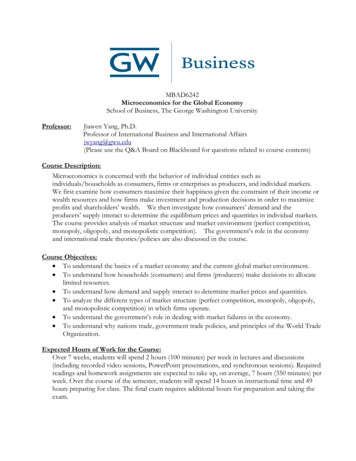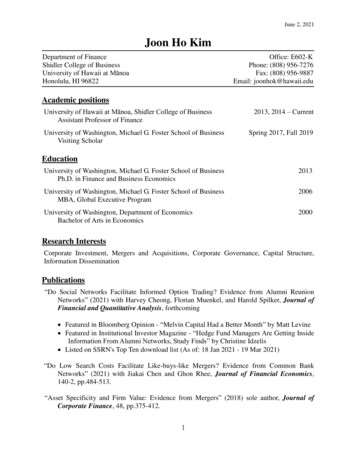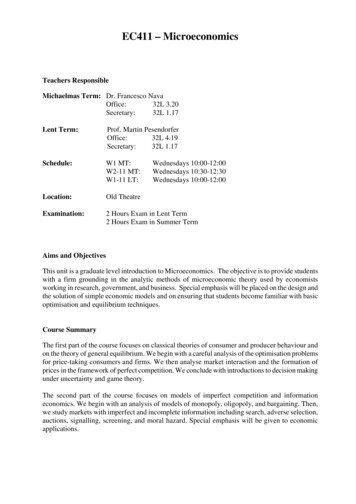
Transcription
EC411 – MicroeconomicsTeachers ResponsibleMichaelmas Term: Dr. Francesco NavaOffice:32L 3.20Secretary:32L 1.17Lent Term:Prof. Martin PesendorferOffice:32L 4.19Secretary:32L 1.17Schedule:W1 MT:W2-11 MT:W1-11 LT:Location:Old TheatreExamination:2 Hours Exam in Lent Term2 Hours Exam in Summer TermWednesdays 10:00-12:00Wednesdays 10:30-12:30Wednesdays 10:00-12:00Aims and ObjectivesThis unit is a graduate level introduction to Microeconomics. The objective is to provide studentswith a firm grounding in the analytic methods of microeconomic theory used by economistsworking in research, government, and business. Special emphasis will be placed on the design andthe solution of simple economic models and on ensuring that students become familiar with basicoptimisation and equilibrium techniques.Course SummaryThe first part of the course focuses on classical theories of consumer and producer behaviour andon the theory of general equilibrium. We begin with a careful analysis of the optimisation problemsfor price-taking consumers and firms. We then analyse market interaction and the formation ofprices in the framework of perfect competition. We conclude with introductions to decision makingunder uncertainty and game theory.The second part of the course focuses on models of imperfect competition and informationeconomics. We begin with an analysis of models of monopoly, oligopoly, and bargaining. Then,we study markets with imperfect and incomplete information including search, adverse selection,auctions, signalling, screening, and moral hazard. Special emphasis will be given to economicapplications.
Teaching and learning methodsOur approach will emphasise analytical methods of reasoning and thus problem-solving exerciseswill be a crucial learning tool. Problem sets will be provided and answers to selected problemswill be discussed during classes. Two assignments per term will be marked.TextbooksThe course will draw mainly on the textbook: Riley, Essential Microeconomics, Cambridge University Press, 2012.The following textbooks can also be useful as additional readings: Mas-Colell, Whinston, Green, Microeconomic Theory, Oxford University Press, 1995. Varian, Microeconomic Analysis, 3rd Edition, Norton, 1992Course Outline: Term 1A. Decision Theory, Consumer Theory and Welfare(1) Riley, Essential Microeconomics, 2012, Chapter 2, 43-78.(2) Spiegler, Bounded Rationality and Industrial Organization, Appendix, 202-212.(3) Caplin, Schotter, The Foundations of Positive and Normative Economics, 2008, Chap 8.Optional Readings:(a) Gul and Pesendorfer, The Case for Mindless Economics, 2005.(b) Riley, Essential Microeconomics, 2012, Chapter 1.B. Producer Theory(1) Riley, Essential Microeconomics, 2012, Chapter 4, 106-130.C. Competitive Markets and Equilibrium(1) Riley, Essential Microeconomics, 2012, Chapter 3, 85-105.(2) Riley, Essential Microeconomics, 2012, Chapter 5, 139-167.D. Choice under Uncertainty(1) Riley, Essential Microeconomics, 2012, Chapter 7, 218-250.E. Game Theory:(1) Riley, Essential Microeconomics, 2012, Chapter 9, 303-338.(2) Shy, Industrial Organization, MIT Press, 1995, Chapter 2, 11‐42.Optional Readings:(a) Kreps, A Course in Microeconomic Theory, Chapters 11‐14.
Course Outline: Term 2A. Monopoly: Price Discrimination1) J. Riley, Essential Microeconomics, 2012, Chapter 4.5, 130-138.2) H. Gravelle and R. Rees, Microeconomics, Longman, 2004, Chapter 9.3) R. Schmalensee, 'Output and Welfare Implications of Monopolistic Third Degree PriceDiscrimination', American Economic Review, 1981.4) E. P. Lazaer, ‘Retail Pricing and Clearance Sales’ American Economic Review, 1986.B. Oligopoly Theory, Repeated Games and Bargaining5) J. Riley, Essential Microeconomics, 2012, Chapter 9, 303-346.6) R. Porter, ‘The Role of Information in U.S. Offshore Oil and Gas Lease Auctions,’Econometrica, 1995.7) D. Fudenberg and J. Tirole, Game Theory, MIT Press, 1991, Chapter 4, Section 4.4.8) A. Mas-Colell, M. Whinston, and J. Green, Microeconomic Theory, Oxford UniversityPress, 1995, Chapter 9, Appendix A, 296-299, and Chapter 12, Sections C and D, 387-405.9) C. d'Aspremont, J. Jaskold Gabszewicz and J.-F. Thisse, 'On Hotelling's "Stability inCompetition"' Econometrica, 1979.C. Search and Adverse Selection10) “Search” (unpublished note for lecture).11) G. Akerlof, 'The Market for Lemons”, Quality Uncertainty and the Market Mechanism',Quarterly Journal of Economics, 1970.D. Games with Incomplete Information and Auctions12) J. Riley, Essential Microeconomics, 2012, Chapter 10.1, 347-350.13) J. Riley, Essential Microeconomics, 2012, Chapter 12.3, 456-462.14) M. H. Bazerman and W. F. Samuelson, I Won the Auction But Don’t Want the Prize,Journal of Conflict Resolution, 1983.15) R. Porter, ‘The Role of Information in U.S. Offshore Oil and Gas Lease Auctions,’Econometrica, 1995.
E. Mechanism Design with Incomplete Information16) R. Myerson, 'Optimal Auction Design', Mathematics of Operations Research, 1981, 58-73.17) J. Riley, Essential Microeconomics, 2012, Chapters 12.5 and 12.6, 474-487.18) A. Mas-Colell, M. Whinston, and J. Green, Microeconomic Theory, Oxford UniversityPress, 1995, Chapter 23D-23F, 891-906.F. Signalling, Moral Hazard and Screening19) M. Spence, 'Job Market Signalling', Quarterly Journal of Economics, 1973.20) B. Salanie, The Economics of Contracts. A Primer, MIT Press, 1997, Chapter 5.21) M. Rothschild and J. Stiglitz, ‘Equilibrum in Competitive Insurance Markets: An Essay on theeconomics of Imperfect Information’, Quarterly Journal of Economics, 1976.
Microeconomic Theory EC411Michaelmas Term1/6Nava (LSE)Microeconomic Theory EC411Michaelmas TermAlthough the course is centered around classical theories of economicbehavior, new developements in these fields will also be discussed.2/6The objective of the course is to provide students with a firm grounding inthe analytic methods of microeconomic theory.Game theory: static and dynamic games and solution concepts.Classical theories of markets and the competitive equilibrium.Classical theories of consumer and producer behaviour.Decision theoretic models of choice: with and without uncertainty.The Michelmas Term part of the course covers:Introduction & ObjectivesNava (LSE)Michaelmas TermLSENavaEC411 Slides 0Microeconomic Theory EC411NotesNotes
Wednesday, 10.00 – 12.00, Week 1Wednesday, 10.30 – 12.30, Week 2-11Old Bulding, Old TheatreWednesday, 13.30 – 15.00Building 32L, Room 3.20Lectures:Office Hours:Markets and Equilibrium:Riley Chapters 3 and 5.Choice under Uncertainty:Riley Chapter 7.Game Theory:Riley Chapter 9 and Shy Chapter 2.Alternative: Kreps Chapters 11-14.345Microeconomic Theory EC411Producer Theory:Riley Chapter 4.2Nava (LSE)Decision Theory & Consumer Theory:Riley Chapters 1 and 2, Spiegler Appendix.1Course ProgramMichaelmas TermMichaelmas Termmoodle.lse.ac.ukCourse Website:Microeconomic Theory EC411f.nava@lse.ac.ukEmail:Nava (LSE)Francesco NavaLecturer:General Information4/63/6NotesNotes
Microeconomic Theory EC411Michaelmas TermMichaelmas Term6/6[K]Kreps, A Course in Microeconomic Theory, Princeton, 1990.Microeconomic Theory EC411[V]Varian, Microeconomic Analysis, 3rd Edition, 1992.Nava (LSE)[M]Mas-Colell, Whinston, and Green, Microeconomic Theory, 1995.Supplentary and Alternative TextbookSome background papers may be suggested to the interested reader.PapersLecture notes can be found on moodle.5/6[R]Include materials required for the evaluations unless otherwise specified.Lecture NotesRiley, Essential Microeconomics, Cambridge University Press, 2012.Main TextbookMaterialsNava (LSE)The exam format has not changed from previous years.The exam will take place in week 0 LT.LT ExamSolutions will be posted throughout the term.Two assignments are required for submission: Mon W7, Fri W10.You are expected to attempt the classwork before the class.The work for each week consists of some exercises.Classes start in week 2 and follow lectures with some lag.ClassesCourse RequirementsNotesNotes
Preferences and ConsumptionNava (LSE)Preferences and ConsumptionCriticism and alternative theories.the Slutsky equation,the Labour market.Applications:Indirect utility function and expenditure function.Demand, substitution and income effects.utility maximization,expenditure minimization,duality.Consumers’ optimization problem:definition preferences,utility representation.Basic decision theory:Roadmap: ConsumptionNava (LSE)Michaelmas TermLSENavaEC411 Slides 1Preferences and ConsumptionMichaelmas TermMichaelmas Term2 / 921 / 92NotesNotes
Preferences and ConsumptionMichaelmas TermNava (LSE)Preferences and ConsumptionMichaelmas Term(1, 1) % (1, 0), (1, 1) % (0, 0), (1, 0) % (0, 1), (0, 1) % (0, 0).X {(0, 0), (1, 0), (0, 1), (1, 1)};Example:% is a preference relation over X .When x % y , the consumer weakly prefers x to y .A typical element is a vector x (x1 , ., xn ).The elements of X are choices (e.g. consumption bundles).X Rn is the set of alternatives (e.g. consumption set).Our primitive is a preference relation over a set of alternatives.Simple Decision TheoryNava (LSE)Simple Decision Theory4 / 923 / 92NotesNotes
Preferences and ConsumptionMichaelmas TermTransitivity: For x, y , z X , if x % y and y % z, then x % z.In the previous example, preferences are not complete.Completeness: If x, y X , either x % y , or y % x, or both.5 / 92Nava (LSE)Preferences and ConsumptionMichaelmas TermShow that transitivity extends to strict preference and indifference.Exercise:6 / 92We say that a preference relation is rational if it is transitive and complete.21Two assumptions on consumer behavior are maintained throughout:Axioms on Consumer BehaviorNava (LSE)In the previous example, (1, 1) (1, 0).x % y and y % x.Indifference ( ): x y if and only ifx % y and not y % x.Strict Preference ( ): x y if and only ifFrom %, we derive two additional relations on X :Strict Preferences & IndifferenceNotesNotes
Rn .Preferences and ConsumptionMichaelmas TermNava (LSE)Preferences and ConsumptionMichaelmas TermHowever, not any rational preference relation can be represented by autility function.If a preference relation can be represented by a utility function, then thepreference relation is rational.U (x ) U (y ) if and only if x % y .A utility function is a function U : X R such that, for any x, y X ,DefinitionUtility FunctionNava (LSE)8 / 927 / 92Aside: Transitivity no longer holds though when we try to aggregate thesepreferences X %A Y %A Z %A X .X %Y %ZY %Z %XZ %X %Ypreferences over candidates in an election:preferences over locations:Venice % Rome, Rome % Paris, Paris % VeniceFor instance, consider:Preferences can be defined over alternatives that do not belong toOther DimensionsNotesNotes
and that x % y if and only ifPreferences and ConsumptionMichaelmas Term9 / 92Nava (LSE)Preferences and ConsumptionU (x ) U (y ) if and only if x % y .Michaelmas TermSuppose that X Rn and that preferences are complete, transitive,continuous, and monotonic. Then there exists a continuous functionU : X R such that, for any x, y X ,TheoremMonotonicity: For any x, y X , if xi yi , i 1, ., n, then x y .Continuity: For any y X , the sets {x X : x % y } and{x X : y % x } are closed.10 / 92Two additional regularity axioms imply a desirable representation theorem:Representation TheoremNava (LSE)No utility function can represent these rational preferences.either “x1 y1 ” or “x1 y1 and x2 y2 ”.Suppose that X R2 Example: Lexicographic PreferencesNotesNotes
Preferences and ConsumptionMichaelmas Term11 / 92Nava (LSE)Preferences and ConsumptionMichaelmas Term12 / 92Convexity: (i) X is convex. (ii) For x, y , z X , if x % z and y % z, thenλx (1 λ) y % z for any λ [0, 1].Occasionally a final axiom is imposed on preferences to ensure that the“weakly preferred sets” are convex.Utility is an ordinal concept. A utility function is a numericalrepresentation of a preference relation.If U (·) is a utility function that represents a preference relation %,the monotonic transformation g (U (·)) also represents %.Consider a strictly increasing function g : R R.Monotonic Transformations & ConvexityNava (LSE)Then, set U (x ) k (x ) and note that x y k (x ) k (y ).y x.Find the scalar k (x ), for which y (k (x ), ., k (x )) X satisfiesConsider any point x in the consumption set.Example: How to Derive a Utility FunctionNotesNotes
Preferences and ConsumptionNava (LSE)Preferences and Consumptionsubject to p1 x1 . pn xn m.U (x1 , ., xn )A consumer chooses (x1 , ., xn ) to maximizem is the income of the consumer.p (p1 , ., pn ) is the price vector;pi is the price of good i;Notation:The Utility Maximization ProblemNava (LSE)Utility MaximizationConsumer TheoryMichaelmas TermMichaelmas Term14 / 9213 / 92NotesNotes
Preferences and ConsumptionNava (LSE) U/ x1p1 U/ x2p2 .Preferences and ConsumptionMRS With two goods, FOC imply thatm px 0, U λpi 0 for any i 1, ., n. xiFOC for an interior, local maximum satisfyL U (x ) λ(m px ).The Lagrangian for the consumer’s problem satisfiesBy LNS we replace px m with the budget line px m.Solving the Consumer’s ProblemNava (LSE)Michaelmas TermMichaelmas Term16 / 9215 / 92Exercise: Show that LNS implies px m if x solves consumer problem.Local Non Satiation: For any x X and ε 0, there exists y X suchthat d (x, y ) ε and U (x ) U (y ).Given x, y Rn , let d (x, y ) denote the distance between x and y .Local Non SatiationNotesNotes
Preferences and ConsumptionMichaelmas TermNava (LSE)Preferences and ConsumptionMichaelmas TermWe often refer dx2 /dx1 as the Marginal Rate of Substitution (MRS)between good 1 and good 2.dx2 U/ x1 MRS.dx1 U/ x2which in turn implies that U Udx1 dx2 0 x1 x2Totally differentiating this curve, yieldsU (x1 , x2 ) k.Consider a two commodities environment and an indifference curveMarginal Rates of SubstitutionNava (LSE)U (x1 , x2 ) k.18 / 9217 / 92If there are only two commodities, a (level k) indifference curve satisfiesDefine an indifference curve as the set of bundles for which utility isequal to some constant.Indifference CurvesNotesNotes
Preferences and ConsumptionMichaelmas Term19 / 92Nava (LSE)m px 0 &Preferences and ConsumptionMichaelmas Term U λpi 0 for any i 1, ., n. xiRecall the FOC of the consumer’s problem,20 / 92Optimality in the consumer’s problem requires the slope of the budget lineto be equal to the slope of the indifference curve.First Order ConditionsNava (LSE)U (x1 , x2 ) min{ax1 , bx2 } Not Differentiable.Perfect Complementsαx2.βx1a MRS .b MRS U (x1 , x2 ) ax1 bx2βU (x1 , x2 ) x1α x2Perfect Substitutes:Cobb-Douglas:ExamplesNotesNotes
Preferences and ConsumptionMichaelmas Term21 / 92Nava (LSE)Preferences and ConsumptionMichaelmas Term22 / 92A function f : Rn R is homogenous of degree k if and only if, for anyt 0 and any x Rn ,f (tx ) t k f (x ).Definitionx (p, m ) x (tp, tm ), for any t 0.Marshallian demands are homogeneous of degree zero in (p, m ), that is,Denote the vector of Marshallian demands by x (p, m ).xi (p, m ), for any i 1, ., n.Solving the utility maximization problem, obtain the Marshallian demands,Marshallian DemandsNava (LSE)If the utility function is quasiconcave, KKT FOC also imply globalconstrained maximum.SOC guarantee that a solution to FOC is local max:Second Order ConditionsNotesNotes
αx2p1 βx1p2 βp1 x1 p2 x2 .αβx1α x2 . Preferences and ConsumptionMichaelmas Termαβand on x2 is.α βα βm.p1 p2Nava (LSE)Preferences and ConsumptionIf p1 p2 , then any x (p, m ) on the budget line.Perfect Substitutes: U (x1 , x2 ) x1 x2 .mIf p1 p2 , then x1 (p, m ) and x2 (p, m ) 0.p1mIf p1 p2 , then x1 (p, m ) 0 and x2 (p, m ) .p2x2 (p, m ) x1 (p, m ) Thus, p1 x2 p2 x2 m impliesAt an optimal choice, x1 x2 .Perfect Complements: U (x1 , x2 ) min{x1 , x2 }.Michaelmas TermExamples: Perfect Complements & Perfect SubstitutesNava (LSE)The fraction of income spent on x1 is αmx1 (p, m ) α β p1 .βmx2 (p, m ) α β p2Marshallian demands hence, satisfySubstituting in the budget line, one obtains that β m.p1 x1 1 αMRS Optimality requires that:Consider a utility function, U (x1 , x2 ) Example: Cobb-Douglas24 / 9223 / 92NotesNotes
MRS (x1 ) 1/2 p1.p2Nava (LSE)Preferences and ConsumptionMichaelmas TermNava (LSE)Preferences and ConsumptionMichaelmas TermOrdinary if its Marshallian demand increases as its price decreases.A good is said to be:Price Changes: Ordinary GoodsIfmp2 0, x2 would become negative which is impossible.p2 p1If so, the following boundary solution appliesmx1 (p, m ) & x2 (p, m ) 0.p1Thus at an interior optimum Marshallian demands satisfy 2mp2p2x1 (p, m ) & x2 (p, m ) .p1p2 p1Optimality requires that: U (x1 , x2 ) 2 x1 x2Consider a quasi-linear utility function:Example: Quasi-Linear Utility26 / 9225 / 92NotesNotes
Preferences and ConsumptionMichaelmas TermNava (LSE)Preferences and ConsumptionMichaelmas TermGiffen if its Marshallian demand decreases as its price decreases.A good is said to be:Price Changes: Giffen GoodsNava (LSE)If a good is ordinary the demand curve is decreasing.Demand curves map equilibrium demands to prices.Price Changes: Demand Curve28 / 9227 / 92NotesNotes
Preferences and ConsumptionNava (LSE)Preferences and ConsumptionIf a good is normal the Engle curve is increasing.Engle curves map equilibrium demands to income levels.Income Changes: The Engle CurveNava (LSE)Michaelmas TermMichaelmas TermNormal if its Marshallian demand increases as income increases.A good is said to be:Income Changes: Normal Goods30 / 9229 / 92NotesNotes
Preferences and ConsumptionMichaelmas Term31 / 92Nava (LSE)Preferences and ConsumptionMichaelmas Term32 / 92We can think of it as utility function defined over prices and income pairs.The indirect utility function depends on the particular representation.v (p, m ) U (x (p, m ))The indirect utility function is obtained plugging the Marshalliandemands in the utility functionCan preferences be defined directly on choice or budget sets?Are we happy about changes in prices and income?The Indirect Utility FunctionNava (LSE)Inferior if its Marshallian demand decreases as income increases.A good is said to be:Income Changes: Inferior GoodsNotesNotes
Preferences and ConsumptionMichaelmas TermNava (LSE)Preferences and ConsumptionAssigned for classes: prove (iv).Michaelmas TermDraw v ’s indifference curves to show the last part of the argument.Exercises:and that lower contour sets are convex.v (p , m ) max{v (p, m ), v (p̄, m )}Thus, either px m or p̄x m, which in turn implies thatλpx λm and (1 λ) p̄x (1 λ) m p x m.It is impossible that px m and p̄x m since:prices p, p̄, and p λp (1 λ) p̄;any bundle x such that p x m.(iii) Consider:Properties of the Indirect Utility FunctionNava (LSE)(ii) Marshallian demands are homogeneous of degree zero in (p, m ).Observation: Under LNS v (p, m ) is strictly increasing in m, but notnecessarily strictly decreasing in every pi (eg perfect substitutes).34 / 9233 / 92Proof (i) When m increases or pi decreases, the set of bundles that satisfythe budget constraint becomes larger.(iv) v (p, m ) is continuous if U (x ) is continuous.(iii) v (p, m ) is quasiconvex in p;(ii) v (p, m ) is homogeneous of degree zero in (p, m );(i) non-increasing in p and non-decreasing in m;The indirect utility function v (p, m ) is:LemmaProperties of the Indirect Utility FunctionNotesNotes
Preferences and ConsumptionMichaelmas Term35 / 92Nava (LSE)Preferences and ConsumptionMichaelmas Term36 / 92This is the dual problem of our original problem, since it has the samesolution to a corresponding utility maximization problem, when wealth ispositive and utility is above 0 utility.If the constraint set is not empty, a solution exists.Assume that U is continuous with LNS preferences.This dual problem reverses the role of objective function and constraint.subject to U (x ) u.pxSuppose that the consumer chooses x to minimizeThe Expenditure Minimization ProblemNava (LSE)Expenditure MinimizationConsumer TheoryNotesNotes
Preferences and Consumption pi hi (p, u ).i 1nNava (LSE)Preferences and Consumption(iv) continuous in p. e (p, u )Moreover, hi (p, u ), for any i 1, ., n. pi(iii) concave in p;(ii) homogeneous of degree 1 in p;(i) non-decreasing in pi , for any i 1, ., n;The expenditure function is:LemmaIf U (x ) is continuous, U (h (p, u )) u.e (p, u ) The expenditure function isThe Expenditure Function & Its PropertiesNava (LSE)Michaelmas TermMichaelmas TermHicksian demand are not observable, only Marshallian demands are.These are also known as compensated demands, as income changes tocompensate for changes in prices so that utility remains constant at u.Hicksian demands are: homogenous of degree 0 in p; and single valuedprovided that preferences satisfy the convexity axiom.Denote the vector of Hicksian demands by h (p, u ).hi (p, u ), for i 1, ., n.The solutions to expenditure minimization problem are known as theHicksian demands,Hicksian Demands38 / 9237 / 92NotesNotes
Preferences and ConsumptionMichaelmas Term39 / 92v (p, e (p, u )) u;xi (p, e (p, u )) hi (p, u ), for i 1, ., n;hi (p, v (p, m )) xi (p, m ), for i 1, ., n.234Nava (LSE)Preferences and ConsumptionThe last two properties tie observables to unobservables.e (p, v (p, m )) m;1Then:prices are strictly positive p 0.preferences satisfy LNS and U (·) is continuous;Suppose that:TheoremMichaelmas TermBoth the expenditure function and the indirect utility function capturevery important properties of the consumer problem.40 / 92Duality: Expenditure Minimization & Utility MaximizationNava (LSE)DualityConsumer TheoryNotesNotes
Preferences and ConsumptionMichaelmas Term41 / 92e (p, u ) ph (p, u ) p x̃,Nava (LSE)Preferences and Consumptionp (x̃ ε) e (p, u ) pε e (p, u ).Michaelmas TermHowever, this contradicts the hypothesis that e (p, u ) is the minimumexpenditure that achieves utility greater than or equal to u, sinceBy continuity, we have that U (x̃ ε) u (x̃ is interior wlog).Consider a bundle x̃ ε, where ε is a small positive vector.where the first equality holds by definition and the second by LNS.Observe thatU (x̃ ) U (h (p, u )) u.Let x̃ be the utility maximizing bundle. Thus,42 / 92Suppose that h (p, u ) does not maximize utility subject to px e (p, u ).Proof of Duality Part 3Nava (LSE)As prices vary, the Hicksian demand gives us the demand that would ariseif expenditure was changed to keep utility constant.Graphical Representation of DualityNotesNotes
Preferences and ConsumptionMichaelmas Term v (p, m ) / pi. v (p, m ) / m43 / 92Nava (LSE)Preferences and ConsumptionMichaelmas TermThis is a great tool, because we can use the derivatives of the indirectutility function to find demands.44 / 92As v is not invariant to utility transformations, the derivative of v w.r.t. pis normalized by the marginal utility of wealth to derive demands.xi (p, m ) This is known as Roy’s Identity and requires that v (p, m ) v (p, m ) xi (p, m ) 0. pi mExploiting the duality theorem, this simplifies to v (p, e (p, u )) v (p, e (p, u )) hi (p, u ) 0. pi mDifferentiating with respect to pi , obtain thatRecall that part 2 duality result establishes that v (p, e (p, u )) u.Roy’s IdentityNava (LSE)Roy’s IdentityDuality ApplicationsNotesNotes
1 2 m21mp1p2 .2m2 p1p1 p2Nava (LSE)Nava (LSE)Michaelmas TermPreferences and ConsumptionSlutsky EquationMichaelmas TermDuality ApplicationsPreferences and Consumption46 / 9245 / 92We can derive the expenditure function from the indirect utility functionand vice versa. e (p, u )2 u e (p, u ) up1 p2p1 p2Note that, by identity 2, we also have that v (p, m ) / p1 x1 (p, m ) v (p, m ) / m m2.p1 p2Thus, Roy’s Identity in this case requiresv (p, m ) The indirect utility of a specific Cobb-Douglas utility function isExample: Cobb-DouglasNotesNotes
Preferences and Consumptionσij (p,m)Michaelmas Term h (p, v (p, m )) 2 e (p, v (p, m )) . p p 247 / 92Nava (LSE)Preferences and ConsumptionMichaelmas TermIt depends only on terms that are, at least in principle, observable.with non-positive diagonal terms.symmetric (since cross-price effects coincide – not intuitive);48 / 92negative semidefinite (by the concavity of the expenditure function);Thus, the substitution matrix must be:θ (m, p ) By construction, the substitution matrix also satisfiesDefine the substitution matrix as the matrix θ (m, p ) satisfying θ11 (p, m ) . θ1n (p, m ) .θ (m, p ) θn1 (p, m ) . θnn (p, m )The Substitution MatrixNava (LSE)θij (p,m) xi (p, m ) xi (p, m ) hi (p, v (p, m )) xj (p, m ) . pj m pj {z} {z}By exploiting the duality theorem, this implies that xi (p, e (p, u )) xi (p, e (p, u )) hi (p, u ) .hj (p, u ) pj m pjDifferentiating with respect to pj we obtainPart 3 duality result establishes that xi (p, e (p, u )) hi (p, u ).Does utility maximization impose any restrictions on consumer behavior?Recall that Marshallian demand curves can be upward sloping.Towards Slutsky EquationNotesNotes
the income effect, xi (p, m )xj (p, m ). mthe substitution effect, σij (p, m );Preferences and ConsumptionMichaelmas Term49 / 92Nava (LSE)Preferences and ConsumptionMichaelmas TermTheory allowed us to derive testable predictions about Dp h.The RHS of the Slutsky equation gives us computable relationship.50 / 92Slutsky equation implies that a change in compensated demand h is equalto the change in the uncompensated demand x due to prices only, plus thechange in uncompensated demand x due to the change in expendituremultiplied by the change in expenditure.Therefore compensated own price effects are non-positive, and othereffects are symmetric.As e is continuous, differentiable and concave, its Hessian is symmetricand negative semi-definite.By the envelope theorem Dp e de/dp h. Therefore, Dp h Dp2 e.Some Intuition: Slutsky EquationNava (LSE)Since σii (p, m ) 0, the Slutsky equation implies that Giffen goods( xi / pi 0) must always be inferior ( xi / m 0).21Two effects discipline how demand responds to a change in the price: xi (p, m ) x (p, m ) σij (p, m) ixj (p, m ). pj mThe Slutsky equation decomposes the effect of a change in the price:Slutsky EquationNotesNotes
Preferences and ConsumptionMichaelmas TermNava (LSE)Preferences and ConsumptionMichaelmas TermHicksian is compensated by increasing wealth to keep utility constant.Graphical Intuition: Slutsky EquationNava (LSE)The converse holds for inferior goods.In other words, hi is compensated by increasing wealth to keep thedecision maker at the same utility, so demand does not fall as much.As xi / m is positive for normal goods, hi responds less than xi .Thus, lower income reduces consumption of xi1 further.When the price increases, income decreases further.The curves intersect at the initial price as duality implies xi0 hi0 .Observe that h is flatter than x, as xi / pi hi / pi 0.Consider a normal good i and an increase to pi :Graphical Intuition: Slutsky Equation52 / 9251 / 92NotesNotes
topi1 .Preferences and Consumption p2U12 U22 p2U12 U22 d λ/dp1dx1 /dp1 dx2 /dp1 d λ/dmdx1 /dm dx2 /dm x1 λ 0 1 0 0 Michaelmas TermNava (LSE)dx1 dp1λp22H̃ x1income effectMichaelmas Termp2 U12 p1 U22H̃Preferences and Consumptionsubstitution effect These conditions are solved to derive income and substitution effects:p2 U12 p1 U22dx1 dmH̃0 p1 p1 U11 p2 U21 0 p1 p1 U11 p2 U21 Differentiating the FOC, we obtain that:Marginal Price Changes: Slutsky EquationNava (LSE) TE SE .IE hi (pi1 , p i , u 1 ) hi (pi1 , p i , u 0 )The income effect can be computed as hi (pi1 , p i , u 1 ) hi (pi0 , p i , u 0 ).TE xi (pi1 , p i , m ) xi (pi0 , p i , m )The total effect can be computed asSE hi (pi1 , p i , u 0 ) h1 (pi0 , p i , u 0 ).The substitution effect can be computed asLet u 0 v (pi0 , p i , m ) and u 1 v (pi1 , p i , m ).Let the price of good i go frompi0Discrete Price Changes: Slutsky Equation54 / 9253 / 92NotesNotes
Preferences and ConsumptionMichaelmas Term55 / 92Nava (LSE)Preferences and ConsumptionMichaelmas Termand labour supply, T x1 (p, pω ), can be downward sloping.dx1 (p, pω ) h1 (p, v (p, pω )) x1 (p, pω ) (T x1 (p, pω )).dp1 p1 mThus, even if leisure is normal, its demand can increase in wages x1 (p, pω ) h1 (p, v (p, pω )) x1 (p, pω ) x1 (p, pω ). p1 p1 mBy the classical Slutsky decomposition, we have thatdx1 (p, pω ) x1 (p, pω ) x1 (p, pω ) T.dp1 p1 m56 / 92The wage affects demand both as a price and as a determinant of income:Posit that ω (T , 0) where T denotes the number of hours available.Denote by: x1 leisure; p1 the hourly wage; x2 consumption; p2 its price.Endowment in Goods: Leisure DemandNava (LSE)Marshallian demand can be upward sloping even for normal goodsprovided that ωi xi (p, m )!as prices directly affect the budget m pω. h (p, u ) x (p, m )dxi (p, pω ) i (ωi xi (p, m)) idpi pi mIf so, Slutsky equation becomesmaxx Rn U (x ) subject to px pω.If so, a consumer chooses Marshallian demand x (p, pω ) by solvingLet the consumer be endowed with goods ω Rn instead of cash m.Endowment in GoodsNotesNotes
Preferences and ConsumptionMichaelmas Term57 / 92Nava (LSE)Preferences and ConsumptionBut that may not help much as well.Michaelmas TermA possible approach would be to think of differences in indirect utility.But we want to think of it more generally, and still include CS.Consumers surplus is one way to assess welfare.58 / 92We want to use the tools developed (expenditure function, indirect utility,conditional demand) to assess how the welfare of the consumer changeswhen parameters such as prices change.Back to standard utility theory
Microeconomic Theory EC411 EC411 Slides 0 Nava LSE Michaelmas Term Nava (LSE) Microeconomic Theory EC411 Michaelmas Term 1 / 6 Introduction & Objectives The Michelmas Term part of the course covers: Decision theoretic models of choice: with and without uncertainty. Classical theories of consumer and producer behaviour.

